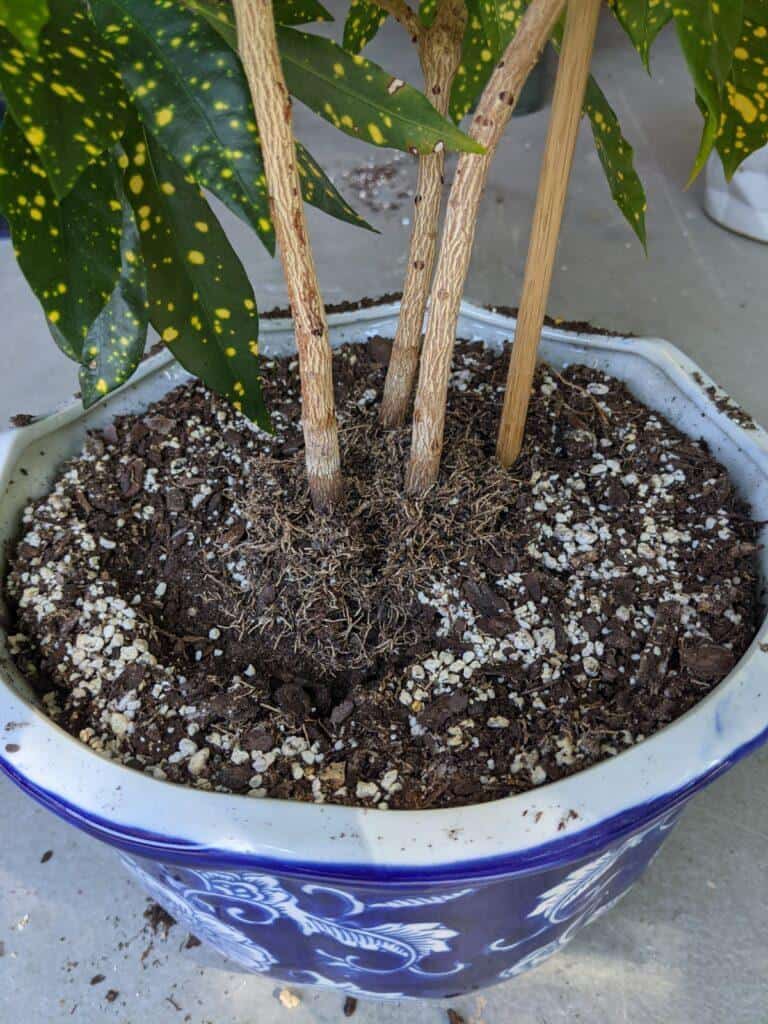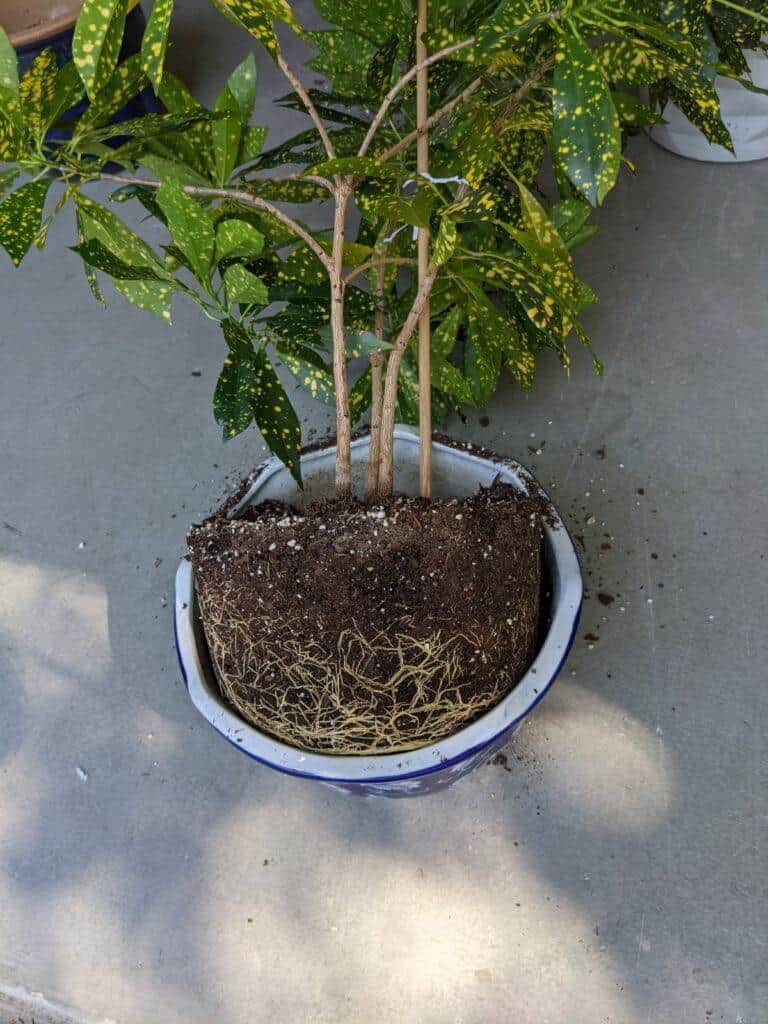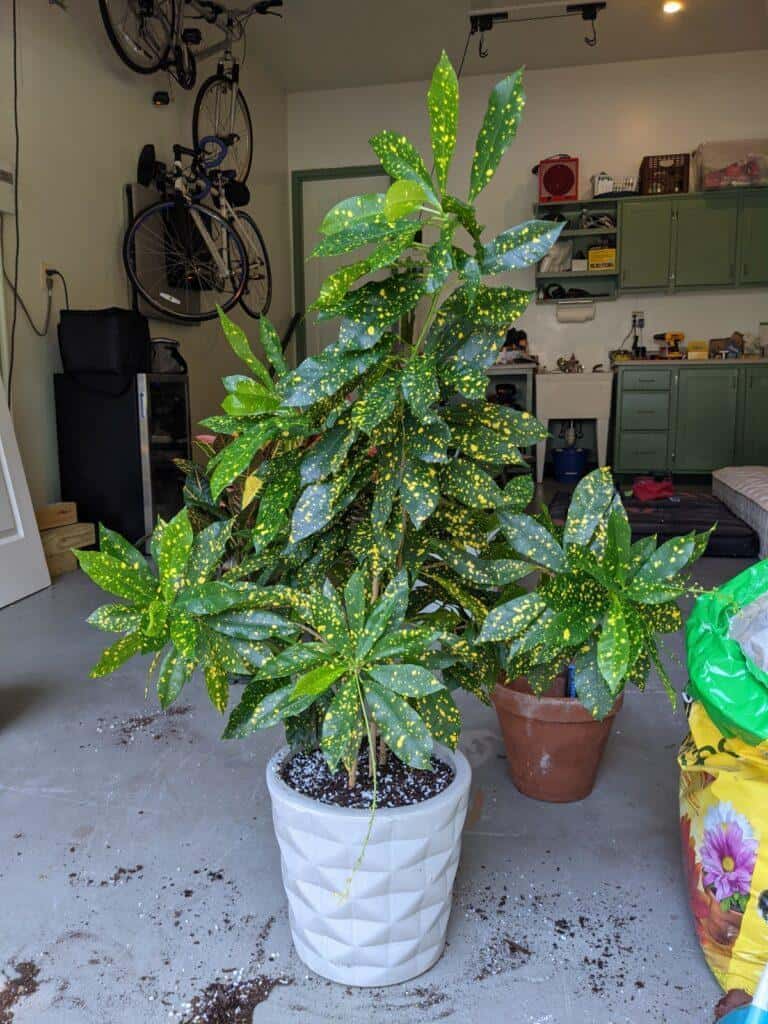My Gold Dust Croton is about eight years old. I’ve repotted it several times over the years. I once saw one that was a nice little tree about five feet tall inside an atrium at a hotel and that is my goal for my Gold Dust Croton. This one is about three feet tall right now and started at about six inches. I’ll probably need to do a good prune to start getting it tree-form ready, but that’s another blog for the future. Today I’ll discuss best practices for repotting Croton.
About Gold Dust Croton
A Gold Dust Croton is a variety of Croton, a genus of the Spurge family, that has small green leaves with yellow specks or dots. Crotons are known for their showy leaf colors and patterns. They are quite divisive among the plant community, some love them, some hate them. Gold Dust Crotons require pretty bright light especially to keep the leaves with vibrant coloring, and I think that might be why some people don’t like them. I have kept mine in a south-facing window and it’s been pretty happy there.
| Light Needs | Watering Needs | Soil Needs | Fertilizing Needs |
| Bright indirect light. | Top inch should be dry before watering. | Well draining potting soil. | Every 2- 4 weeks during the growing season. |
My Gold Dust Croton flowers almost constantly during the growing season, but the flowers are teeny tiny and unremarkable. If I’m being honest, they’re kind of annoying too because they drop stuff everywhere. I tend to keep mine on the dry side. I let the soil dry several inches between waterings. If you wait long enough, the leaves will begin to droop a little when it needs a drink. See the table above for some basic care instructions for your Gold Dust Croton.
Timing for Repotting Croton
Gold Dust Croton Showing Roots
If your Gold Dust Croton is showing roots either out of the bottom of the pot or out of the top of the soil, that’s a sign that you want to repot. The roots need more room and more soil to grow into. More soil provides new nutrients and the ability to hold more moisture. I can see some roots from the top of my soil line. These are old roots but I guess over time some soil has washed away or new roots have developed at the bottom pushing these old ones up. I don’t want that. I want the roots to be fully covered.

Gold Dust Croton Yellowing Leaves
If your Gold Dust Croton has yellowing leaves, don’t panic just yet. Gold Dust Crotons can be finicky. If the leaves were droopy and your plant needs a drink, that could be causing your yellowing leaves. It may not require a repot though, only if your plant is drying out too quickly between waterings. The lowest leaves on the branch are turning yellow on my Gold Dust Croton if I have gone too long between watering. If the leaves are turning yellow elsewhere on the plant that could be due to overwatering, under watering, or fertilizer issues. A cheap and foolproof way to monitor soil moisture is a soil moisture meter. I know if you’re reading this blog, you probably already know, but the Gold Dust Croton has yellow dots on the leaves as a feature. I once had a houseguest insist that my Gold Dust Croton was sick and I got a good chuckle from that.

How to Repot a Croton
You don’t need anything special to repot a Gold Dust Croton. The basics are a new pot and some potting soil. The new pot should be about two inches in diameter larger than your old pot if you are up potting. The new pot must also have drainage holes, Crotons do not like to be soggy. If you need to add drainage to your pot follow my tutorial on drilling ceramic and glass plant pots. Gold Dust Crotons will do fine in regular potting soil. You may want to amend the potting soil with a little extra perlite to your Gold Dust Croton soil mix.
Now for the repotting instructions. First, remove your Gold Dust Croton from its old pot. Do this carefully especially if it’s rootbound. Once it is out of the pot inspect the roots. The roots of my Gold Dust Croton were really filling out the bottom of this pot. I also noticed that over time the soil had washed away from the roots at the top of the pot so I wanted to repot it into a deeper pot. The roots should be white or light brownish and firm if they are healthy. If they are brown or mushy, follow up with my blog on overwatering for steps to address that.

After you have inspected the roots you can loosen the root ball a bit. Then fill your new pot with your soil mix to the height you want to place the bottom of your root ball. Backfill soil around the root ball and a bit over the top of the root ball. Repotting Crotons is easy, you can see the final results below.

Should You Water After You Repot?
Not immediately. Wait a day or two. Repotting can shock your plant and then watering can cause further stress. It’s best to time your repot when your plant is not thirsty, but also not right after you just watered.
Are you pro-Croton, or do you think they are too gaudy? Also, share your repotting best practices below.

I'm a long time plant lover on the quest to happily coexist with as many plants as I can. Let's grow!
